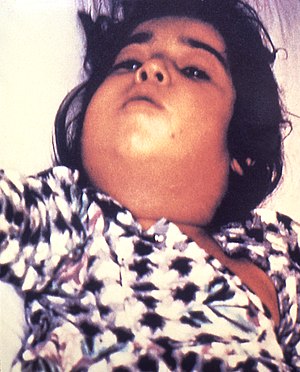Diphtheria carrier state
| Diphtheria | |
|---|---|
 |
|
| Diphtheria can cause a swollen neck, sometimes referred to as a bull neck. | |
| Specialty | Infectious disease |
| Symptoms | Sore throat, fever, barky cough |
| Usual onset | 2–5 days post-exposure |
| Causes | Corynebacterium diphtheriae (spread by direct contact and through the air) |
| Diagnostic method | Throat appearance, culture |
| Prevention | Diphtheria vaccine |
| Treatment | Antibiotics, tracheostomy |
| Frequency | 4,500 (reported 2015) |
| Deaths | 2,100 (2015) |
| Classification |
· ·
|
|---|---|
| External resources |
Diphtheria is an infection caused by the bacterium Corynebacterium diphtheriae. Signs and symptoms may vary from mild to severe. They usually start two to five days after exposure. Symptoms often come on fairly gradually, beginning with a sore throat and fever. In severe cases, a grey or white patch develops in the throat. This can block the airway and create a barking cough as in croup. The neck may swell in part due to large lymph nodes. A form of diphtheria that involves the skin, eyes, or genitals also exists. Complications may include myocarditis, inflammation of nerves, kidney problems, and bleeding problems due to low blood platelets. Myocarditis may result in an abnormal heart rate and inflammation of the nerves may result in paralysis.
Diphtheria is usually spread between people by direct contact or through the air. It may also be spread by contaminated objects. Some people carry the bacteria without having symptoms, but can still spread the disease to others. The three main types of C. diphtheriae cause different severities of disease. The symptoms are due to a toxin produced by the bacteria. Diagnosis can often be made based on the appearance of the throat with confirmation by microbiological culture. Previous infection may not prevent against future infection.
A diphtheria vaccine is effective for prevention and available in a number of formulations. Three or four doses, given along with tetanus vaccine and pertussis vaccine, are recommended during childhood. Further doses are recommended every ten years. Protection can be verified by measuring the antitoxin level in the blood. Treatment is with the antibiotics erythromycin or benzylpenicillin. These antibiotics may also be used for prevention in those who have been exposed to the infection. A surgical procedure known as a tracheotomy is sometimes needed to open the airway in severe cases.
...
Wikipedia
